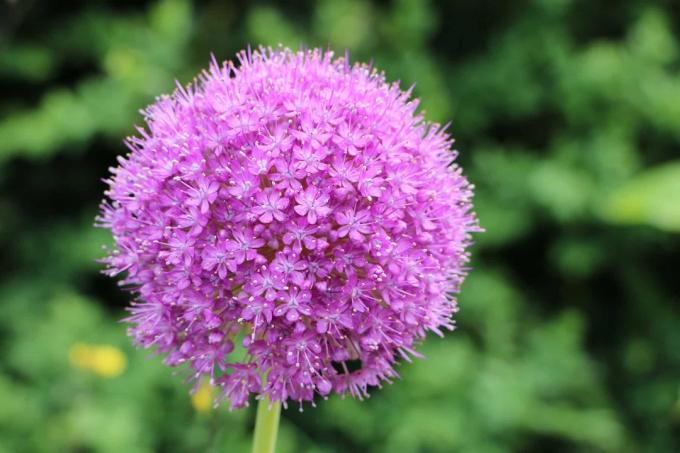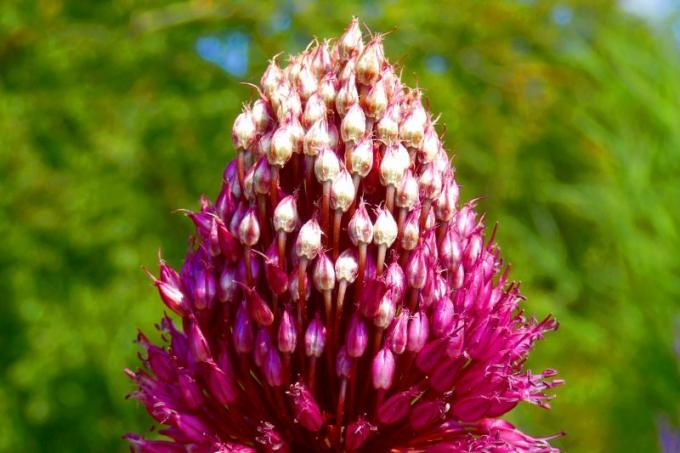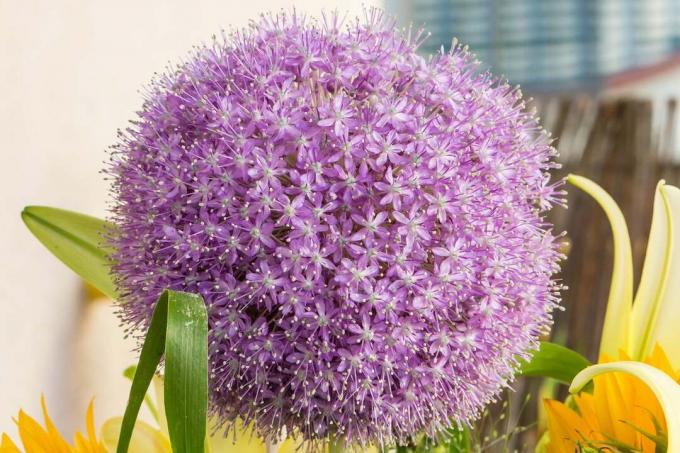
Ornamental onions are very decorative and an insect-friendly plant. In order for the ornamental onion to bloom “on time” in spring, there are a few tips to heed when planting.
In a nutshell
- Fall planting ideal
- Spring planting only under certain conditions
- when planting in tubs, observe limited planting times
Table of contents
- Choose the best time
- spring planting
- Note frost
- Consider region conditions
- Plant in warm weather
- balcony planting
- frequently asked Questions
Choose the best time
The bulbs of the ornamental onion (Allium) need a certain amount of time to get used to the soil conditions and to take root. Because the flowering period starts in early spring from April or May, depending on the variety, you should amaryllis plant in the previous year. Best is between September and October. Then the ground is still warm from the summer. Depending on the weather, ornamental onions can be planted until the beginning of December. After that it should be over.

Notice: Many flower bulbs generally thrive better when given cold weather before the growing season, which also promotes flowering. This is also the case with ornamental onions, which is why autumn planting is the best choice of planting time.
spring planting
If you forgot to plant ornamental onions in autumn, you can still plant them in spring under certain conditions. You should only choose varieties that flower in May at the earliest and can be planted at least six weeks beforehand, from mid to late March. April varieties would have to be planted in February and this is not promising due to the usual weather conditions.
The following are some “late flowering” ornamental onion varieties:
- Blue onion (Allium caeruleum): flowering from June
- Bulgarian leek (Nectaroscordum siculum ssp. bulgaricum): flowering time from May
- Gold Allium (Allium moly): Flowering time from May
- Giant leek (Allium giganteum): flowering period from June
- Schubert's ornamental onion (Allium schubertii): flowering from May
- Black purple leek (Allium atropurpureum): flowering from June
- Star ball leek (Allium christophii): flowering period from June

Notice: The Bulgarian leek (Nectaroscordum siculum ssp. bulgaricum) does not belong to the Allium family, but comes very close as a leek plant. That's why it shouldn't be missing from the list here.
Note frost
Frost plays an essential role in the ideal time for planting ornamental onions. Basically, you should only plant the bulbs when there is no frost. In frost, digging the planting hole is difficult or impossible. If there is frost shortly after planting ornamental onions, too much cold can get through the soil to the bulb because the freshly filled soil has not yet settled sufficiently.
Consider region conditions
In a mild region, frost is usually much longer in coming and there the frost can already be over in early spring. Then the milder temperatures often allow planting until the beginning of December and plantings from February.
In cooler regions such as the Alps, however, the risk should not be taken and planting should take place by October at the latest and from the end of March at the earliest. In particularly cold winter regions, ornamental onion varieties should therefore also be used that only bloom in summer, such as ball onions (Allium sphaerocephalon) with a blooming period July. This can be planted as early as mid-May after the ice saints and thus without risk of frost.

Plant in warm weather
Too much cold or frost is bad for the healthy and flowering growth of ornamental onions, but too warm weather conditions can also have a negative impact. Therefore, planting between June and the end of August is not recommended. If it is too warm when planting or shortly afterwards, this stimulates growth immensely and the ornamental onions sprout strongly. This costs the plant a lot of energy, which means that fewer flowers usually form and the flowering time is significantly reduced. In the worst case, there may be no flowering at all. Therefore, when planting, it is always important to plant at cooler temperatures and to monitor them until flowering in order to be able to provide cooler shade if necessary.
balcony planting
If you want to put your ornamental onion in a flower box or bucket, you should take into account the significantly higher influence of cold. Because only limited soil is available, it cools down more quickly in autumn due to lower night-time temperatures and the summer heat usually no longer has an effect until mid/end of October. It is therefore advisable to plant by mid-September at the latest and to ensure that the location is in full sun in order to be able to catch the last warm rays of the sun.

In spring, you should not plant the ornamental onions before April. It is even better to choose late-blooming varieties so that they can still be planted in mid-May after the ice saints. If it is not too warm on your balcony in late spring/early summer, you can plant the ornamental onion here until June.
frequently asked Questions
You should follow the recommendations for autumn planting so that the ornamental onions can take root as best as possible before the onset of winter. If the alternative spring planting was also missed, you should store the bulbs in a dry, dark and cool place until the next planting date in autumn.
Here, too, autumn is between September and October at the most suitable time and spring at the alternative time. Because it is a cold germ, frost must hit the seed or the seed must first be placed in the freezer. However, sowing is not common because the chances of germination and vigorous growth are low and the effort involved is disproportionate.
If there is no frost for a short time after the time of planting, no protection against the cold is required for the mostly very hardy varieties. However, if the interval between planting and frost is less than three weeks, protection against the cold makes sense. After planting in tubs or flower boxes in early autumn, a wind-protected location is usually sufficient to promote rooting.



